The third and final chapter in Chris Nolan’s Batman trilogy delivers plenty of spectacular visuals and mind-boggling vfx scenes that linger in memory long after the final credits roll.
The stakes are bigger than ever for Batman in The Dark Knight Rises, the final installment in director Christopher Nolan’s acclaimed and popular trilogy. With sky-high expectations to meet, Nolan relied on his tried-and-true collaborators at Double Negative to handle the visual effects work and animation on the film.
Under the supervision of Paul J. Franklin, who has worked with Nolan on all three Batman movies as well as Inception, Double Negative created almost all of the film’s inspired visual effects, from a stunning aerial hijacking that opens the film to the final battle for Gotham City.
Based on the popular DC Comics character, The Dark Knight Rises pits Christian Bale as Batman against the menacing terrorist Bane, played by Tom Hardy. With the help of Anne Hathaway as Catwoman and series stalwarts Gary Oldman as Commissioner Gordon, Michael Caine as the loyal Alfred and Joseph Gordon-Levitt as Officer John Blake, Batman makes a final stand for justice in a city besieged by terror.
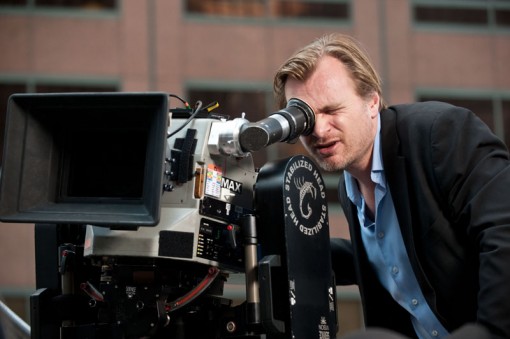
Despite being nearly three hours long and featuring some stunning imagery, the visual effects shot count came in at 450—a fraction of what most tent-pole superhero epics require, Franklin says.
That reflects Nolan’s approach to filmmaking, which is to do as much as possible in camera and use effects only when there is no other way to get a shot.
“He’s not unrealistic about what is achievable in reality. Very quickly, he’ll realize some things can’t be done for real, so he’ll go to a fully digital solution when he needs to,” Franklin says. “He’s very much a believer in filming as much as you can, getting as much into the camera as possible and then using that as a basis to work from in terms of the digital effects.”
That creates a high level of reality and requires the visual effects to match the high quality and realism of the live-action imagery.
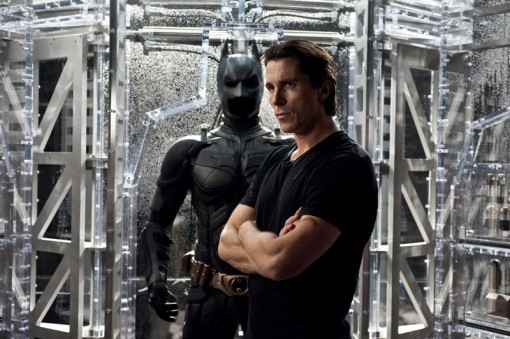
Compensating for that required extensive preparations on Double Negative’s behalf. Franklin says a lot of time was put into documenting and surveying locations, scanning the cast members and making very detailed lighting maps using high-dynamic range imaging cameras that accurately record on-set lighting.
One of the key tools developed for the movie is a ray-traced rendering system that works within Double Negative’s pipeline and lighting set.
“It correctly calculates the exchange of energy between surfaces,” he says, creating realistic lighting for different surfaces. The process requires a lot of raw computing power to calculate, but the results are worth it because it gives objects like the Batpod or Batman’s Tumbler vehicle an inherent level of reality that can be easily adjusted.
“The results are so consistent out of this new tool set that instead of giving these precise grading instructions like, ‘Make that surface a little bit brighter,’ ‘Take that highlight down,’ ‘Add a little more contrast to the rear tire,’ I could just say make it darker, make it lighter. That’s literally all I had to do because everything else was sitting together so perfectly it just dropped right into the shot.”
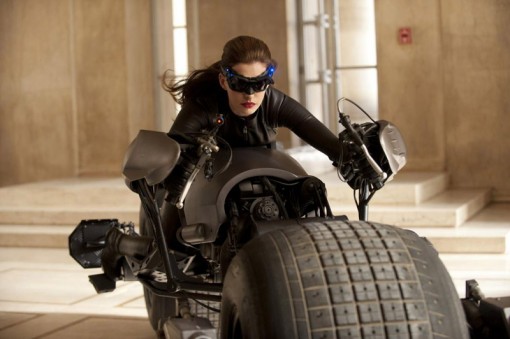
The film features several major effects sequences, starting with the opening hijacking sequence in which Bane’s crew skydive from a C-130 Hercules to a CIA jet, breaking in, escaping with a prisoner and destroying the jet—its wings sheared off and fuselage snapped in two.
Franklin says the sequence was heavily prevized with a detailed animatic that allowed the production to work out what could be done with stunts and live action, and what needed to be visual effects. The result was a mix, with miniatures and effects used to show the wings breaking off, combined with shots of a real fuselage and both live-action and animated skydivers.
Another major sequence involves Bane setting off explosives under a football stadium, causing the field to collapse under football players who tumble into the cataclysm. Previz was used to plan a live-action shoot, in which stuntmen fell through holes in a platform built above the field. Franklin says additional players were animated and the entire field was generated with CG.
“That was a really tricky thing,” he says. “It was physics, but we needed a high level of control over the whole thing so we could choreograph the whole thing and make sure it was synchronized with the action of the players.”
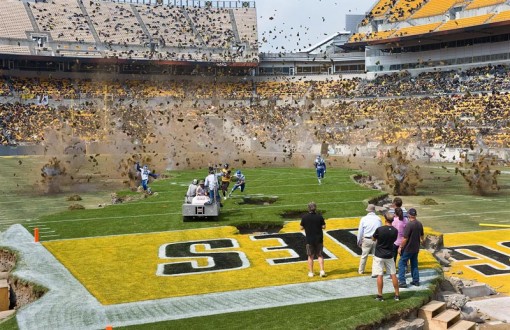
Franklin says they also extended the crowd, using as a basis the 11,000 or so people who showed up to sit in the stands for a shoot at Pittsburgh’s Heinz Field.
Nolan’s approach was especially evident in what Franklin said was his biggest challenge as VFX supervisor on the movie: a climactic aerial chase through Gotham City in which Batman pursues an armed nuclear device while avoiding missiles. Some shots feature a real vehicle suspended from a support arm and cable that had to be scrubbed from frames, while others required a full digital version.
Nolan also expanded his use of IMAX for the film, filming about half of the movie using the high-definition large format frame. Franklin says having done IMAX sequences for The Dark Knight had prepared Double Negative for working in IMAX, whose large frames require about 20 times the data of a normal 2K image.
“It’s a huge logistical effort to move data around,” he says. “In terms of a creative point of view, you cannot really see what you’re working on because there aren’t any digital screens that can display images of this resolution.”
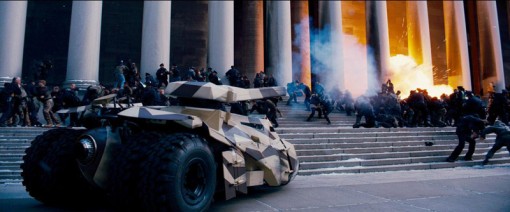
Effects artists could look at a proxy image or at part of an image, but the only way to see the complete image was to output to IMAX, a process that required several days and could only be done in the United States. Often, the first person to view those images was Nolan.
As with most effects-heavy films, animation was used on digital doubles of main characters, including Batman and Catwoman. On The Dark Knight Rises, the sequences needing digital keyframe animation doubles were often when the characters were riding vehicles like the Batpod.
“It’s more about holding a really strong pose,” Franklin says.
Keyframe animation also was used on the vehicles themselves. One scene calls for the Batpod to escape a trap by riding up a ramp and using it as jump to escape.
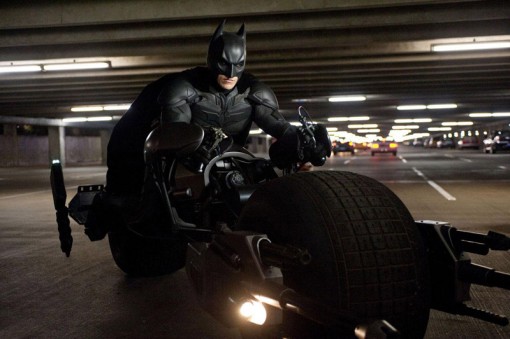
“The biggest challenge was to make it look convincing that it could jump off a ramp, because it’s not a light and lean bike,” Franklin says. A real stunt bike was filmed doing the stunt, and the effects crew then progressively replaced it with a digital Batpod, adjusting it to the physics of the real bike’s jump.
Additionally, a lot of time was spent studying Apache gunships and Huey helicopters to get the maneuvers of the Bat to look as realistic as possible. Franklin says research turned up a lot of amazing real stunts that were referenced for the film.
“All the maneuvers that you see the Bat doing in the film, no matter how extreme, they’re all based on something we found reference for.”
The sequence was one of Franklin’s favorites, as it includes several action beats suggested by Double Negative in which heat-seeking missiles pursue the Bat. Nolan allowed Franklin to use a helicopter with low-fly permission on location in Pittsburgh to shoot all the background plates for the sequence.
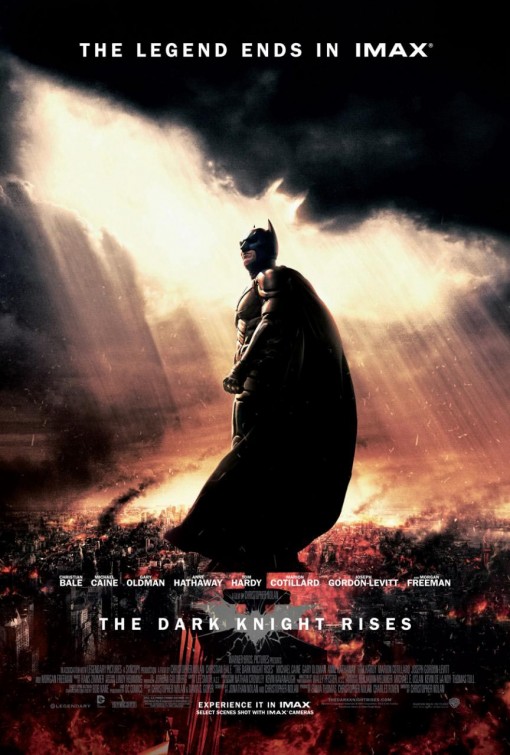
The final bit of significant animation in the movie is the return of the digital bats from Batman Begins. This time, however, they were in IMAX and had to be recreated at a much higher level of detail and then animated into the shot.
Warner Bros. The Dark Knight Rises opened in theaters nationwide last month.




 Win a Funko X Lilo & Stitch Prize Pack!
Win a Funko X Lilo & Stitch Prize Pack! 
